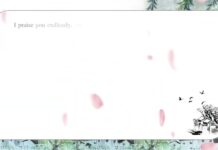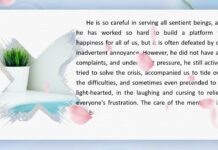–Volume 2 (Part 1)
Author: Fafu
Translator : Lotus
Dear Dharma friends,hello everyone. Welcome to this episode of the podcast contributed by the Buddhas’ Practice Incorporated of Australia.
Today, we will delve into “Observing the River and Discerning Views” from the second volume of the Shurangama Sutra, to appreciate the Buddha’s revelation of the non-arising and non-ceasing nature of the wondrously clear true mind. With a devout heart, let us together explore this sublime Dharma door!
1. Losing the Original True Mind: The Deluded State Since Beginningless Time
Before the Buddha’s exposition on “Observing the River, Discerning Perception,” Ananda and the assembly were in a state of mental and physical unease, shrouded in confusion. Since beginningless eons, they had “lost their original true mind,” unaware of the nature of the wondrously clear true mind. They mistakenly took the six sense objects (such as form, sound, and smell) as real, falsely identifying with “conditioned objects” and making distinctions based on the shadows of external phenomena and afflictive delusions. This false cognition is akin to a person lost on the path, unable to recognize their true self.
When the Buddha, with great compassion, expounded the truth, Ananda and the assembly suddenly attained clarity, experiencing a serene and joyful state of “body and mind at peace.” This realization was akin to “a child who has lost its mother suddenly being reunited with her kind embrace,” filling their hearts with a sense of belonging and tranquility. They joined their palms and bowed to the Buddha, expressing their earnest aspiration to further understand the true principles of “the reality and illusion of body and mind” and “the nature of arising and ceasing versus the non-arising and non-ceasing.”
3. Observing the River, and Discerning Views: The Essential Nature of Awareness as Non-Arising and Non-Ceasing
To guide the assembly toward realizing the “non-arising and non-ceasing” nature, the Buddha engaged in a profound dialogue with King Prasenajit.
The Impermanence of the Physical Body: Moment-by-Moment Change, Like Fire Turning into Ash
The Buddha first pointed out that King Prasenajit’s physical body is impermanent, changing moment by moment, like fire turning into ash, ultimately subject to aging and dissolution. The body undergoes constant transformation, arising and ceasing incessantly.
Essential Nature of Visual Awareness Does Not Perish: Observing the River Without Distinction of Youth or Old Age
The Buddha further asked: In the process of the physical body’s transformation and decay, is there something that “does not perish”? King Pasenadi initially responded that he did not know. The Buddha then used the water of the Ganges River as a metaphor to guide his reflection: Although the physical body ages and wrinkles appear with the passing years, the “essential nature of visual awareness that observes the river” (the faculty of seeing) remains constant. Whether in childhood or old age, the essential nature of visual awareness that observes the Ganges River “remains unchanged,” without distinction between youth and old age.
The Buddha concluded: “That which wrinkles is subject to change; that which does not wrinkle is not subject to change. What changes is subject to arising and ceasing, but that which does not change is fundamentally without birth or extinction.” The wrinkles of the physical body represent change and are subject to arising and ceasing; however, the essential nature of visual awareness does not wrinkle, does not change, and thus is without birth or extinction. This is precisely the unborn and undying nature of the wondrously clear true mind.
The core of “Observing the river and discerning views” lies in comprehending the wondrously clear true mind of neither birth nor death from within oneself.
4. The Assembly’s Joy: The Self-Nature Is Unborn and Undying
Upon hearing this teaching, King Pasenadi and the assembly suddenly gained clear understanding. They sincerely believed that “abandoning this life to take up another” is merely a phenomenon, while the true self-nature—the essential nature, the true mind—is unborn and undying. King Pasenadi thus affirmed that “the true self is unchanging,” and the assembly, through this realization, was “filled with joy and experienced something unprecedented.”
5. Ananda’s Further Question: What Is Meant by “Upside-down”?
Although the assembly had gained some enlightenment, Ananda still harbored doubts: If the nature of awareness and hearing is indeed “unborn and undying,” why did the Buddha say that sentient beings “lose their true nature and act in delusion”? The Buddha used the example of “raising a hand” to explain the difference between “upright” and “inverted”: Ordinary people consider raising a hand as “upright” and lowering it as “inverted,” yet they do not realize this is merely a relative perspective. Similarly, sentient beings mistakenly regard the deluded mind and physical body as their true nature, erroneously taking the phenomena of arising and ceasing as real, while overlooking the unborn and undying true mind. Thus, Ordinary people ‘s bodies as “upside-down.”
The Buddha further pointed out that his pure Dharma body (self-nature) is “right and all-encompassing knowledge,” pervading space and encompassing the entire Dharma realm. The upside-down of sentient beings arises precisely because they mistake the false for the true.
6. Conclusion
In the Shurangama Sutra, “observing the river and discerning views” is of utmost importance! May all Dharma friends take this as a guide and diligently realize it! Thank you, everyone!





